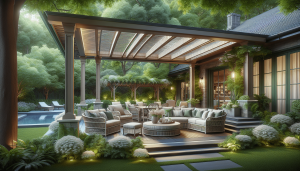Are you considering adding a mother-in-law suite to your home in Bell County, TX? This guide will help you navigate the planning process, from understanding legal requirements to maximizing comfort in your new space. We’ll cover essential steps like assessing zoning regulations, budgeting, and hiring the right contractor in Harker Heights, Killeen, or Copperas Cove. By the end, you’ll have a clear roadmap for creating a functional and welcoming living space for your loved ones.
Key Takeaways
- Mother-in-law suites can increase home value and provide independent living space for family members
- Careful planning, budgeting, and understanding local regulations are essential for successful suite additions
- Universal design principles and energy-efficient features enhance comfort and functionality in mother-in-law suites
- Selecting an experienced contractor and understanding the construction timeline are crucial for project success
- Future-proofing the suite with adaptable design elements ensures long-term usability as needs change over time
Understanding the Importance of a Mother in Law Suite Addition

A mother-in-law suite addition can significantly enhance your home’s value while providing independent living space for family members. These versatile room additions often include a Kitchen Remodeling Copperas Cove, bathroom, kitchen, and accessible features. Whether you’re converting an attic or building from scratch, careful Element Construction Location and budgeting are essential. Let’s explore Schedule a Quick Consult how this addition can benefit your home and family.
Enhancing Your Home's Value With an in-Law Suite
Adding a mother-in-law suite to your home can significantly boost its value. This secondary suite, often built as a bedroom extension or by converting your basement, provides versatile living space that appeals to a wide range of potential buyers.
You’re not just adding square footage; you’re creating a multi-functional area that can serve as a guest room, home office, or rental unit.
When planning your mother-in-law suite addition, consider how it integrates with your existing home’s structure and roof. A well-designed secondary suite that complements your home’s architecture can increase its curb appeal and overall market value.
Remember, the key is to create a space that offers privacy and independence while still being connected to the main house.
Providing Independent Living Space for Family Members
A mother-in-law suite addition provides independent living space for your family members, offering privacy and autonomy while keeping them close. This arrangement can be particularly beneficial if you’re considering refinancing your home to fund the addition, as it may increase your property value.
You’ll need to consult with a real estate agent to understand how this addition impacts your home’s market value and potential resale opportunities.
When planning the suite, consider including features that promote independence, such as a separate entrance and a kitchenette. You might also want to explore options for a home equity line of credit to finance these modifications.
Remember to update your home insurance policy to cover the new living space, ensuring both you and your family members are protected in this unique living arrangement.
Exploring the Versatility of Mother in Law Room Additions
Mother-in-law suite additions offer remarkable versatility in your home renovation projects. You can transform underutilized spaces like an attic, basement, or garage into a functional living area. These room additions provide flexibility, allowing you to create a private retreat for guests, a home office, or even a rental unit to generate extra income.
When planning your mother-in-law suite, consider incorporating large windows to maximize natural light and create an open feel in the space. You can customize the layout to include a small kitchenette, bathroom, and living area, making it a self-contained unit within your home.
This versatility not only enhances your property‘s value but also adapts to your changing needs over time.
Assessing Legal Requirements and Zoning Regulations

Before starting your mother-in-law suite addition, you must navigate the legal landscape. Research local building codes, obtain necessary permissions, and understand zoning restrictions for accessory dwelling units.
These steps ensure your home improvement project complies with real estate regulations, protecting your property and investment.
Researching Local Building Codes for in-Law Suites
When researching local building codes for your mother-in-law suite addition, you’ll need to consider the cost implications of various construction requirements. These codes may dictate specific floor plans, minimum square footage, and shower installation standards.
Understanding these regulations early in the planning process can help you avoid costly mistakes and ensure your project complies with local laws.
You should also investigate whether your municipality allows the suite to generate rental income, as some areas have restrictions on this. Additionally, familiarize yourself with fire safety requirements, which may influence your construction choices, such as the need for fire-resistant materials or emergency exits.
By thoroughly researching these codes, you’ll be better prepared to create a safe, legal, and functional living space.
Obtaining Necessary Permissions for Your Addition
Before starting your mother-in-law suite addition, you must obtain the necessary permissions from local authorities. This process involves submitting detailed design plans that comply with aging-in-place standards and zoning regulations.
You’ll need to consider factors like renting potential and insurance requirements when preparing your application.
To secure approvals, you may need to present your mother-in-law suite design to a planning committee. They’ll assess how your addition impacts the neighborhood and ensure it meets all safety standards.
Be prepared to make adjustments to your plans based on their feedback, which could affect your timeline and budget. Remember, obtaining proper permissions is crucial for avoiding legal issues and ensuring your addition adds value to your property:
| Permission Type | Issuing Authority | Key Considerations |
|---|---|---|
| Building Permit | Local Building Department | Design compliance, safety standards |
| Zoning Approval | City Planning Office | Land use, setbacks, height restrictions |
| Health Department Approval | County Health Department | Septic system, water supply |
| Homeowners Association Approval | HOA Board | Exterior design, property use |
Understanding Zoning Restrictions on Accessory Dwelling Units
When planning your mother-in-law suite addition, you need to understand zoning restrictions on accessory dwelling units. These laws regulate the size, location, and use of your new living space.
Check with your local estate agent or zoning office to learn about specific requirements for your area, such as minimum lot sizes, setback rules, and occupancy limits.
Zoning laws may also impact your suite’s utilities and design. You might need to install separate electricity meters or limit the size of your kitchen countertop.
Understanding these restrictions early in the planning process helps you design a compliant dwelling that meets your family’s needs while staying within legal boundaries. Consider the following key factors when navigating zoning restrictions:
- Size limitations for the accessory dwelling unit
- Parking requirements for additional residents
- Restrictions on renting out the space
- Design guidelines to maintain neighborhood aesthetic
- Utility connection and metering regulations
Planning the Design and Layout of Your in-Law Suite Addition

Planning your mother-in-law suite addition involves key decisions about design and layout. You’ll need to choose between attached or detached suites, incorporate essential amenities, ensure privacy and accessibility, and review floor plans.
Consider factors like assisted living needs, furniture placement, and heating options. A well-planned suite can provide comfortable living space while potentially increasing your home’s value.
Choosing Between Attached or Detached Mother in Law Suites
When deciding between attached or detached mother-in-law suites, consider your home construction options and available space. An attached suite can be a cost-effective investment, utilizing existing walls and utilities.
You might integrate it seamlessly by converting a garage or extending your home, potentially adding a porch for a welcoming entrance.
A detached suite offers more privacy but may require additional permits and utility connections. This option allows for greater design flexibility, including features like a full kitchen sink.
Remember to factor in potential tax implications for either choice, as adding living space can affect your property assessment.
Incorporating Essential Amenities in the Suite
When incorporating essential amenities in your mother-in-law suite, prioritize a functional kitchenette and accessible toilet. Consult an architect to optimize the layout, ensuring these features fit comfortably within the available space.
Consider installing a compact refrigerator, microwave, and sink in the kitchenette to promote independence.
Work with an interior designer to maximize the ceiling height, creating an open feel in the suite. They can help you select space-saving fixtures and furniture that complement the overall design.
Remember to include adequate storage solutions and proper lighting to enhance the living experience:
| Essential Amenity | Key Considerations |
|---|---|
| Kitchenette | Compact appliances, adequate counter space |
| Bathroom | Accessible fixtures, grab bars |
| Sleeping Area | Comfortable bed, storage options |
| Living Space | Multi-functional furniture, entertainment center |
Creating Privacy and Accessibility for Residents
When creating privacy and accessibility in your mother-in-law suite, consider installing soundproof walls and choosing carpet to minimize noise transmission. Add a separate entrance to promote independence, and ensure stairs have proper handrails for safety.
These features not only enhance comfort but can also increase your return on investment when it’s time to sell.
To maximize accessibility, install grab bars in the bathroom and widen doorways for easy navigation. Consider financing options like a home equity line or refinancing your mortgage to cover these modifications.
Remember, creating a space that’s both private and accessible will make your in-law suite more appealing and functional:
- Install soundproof insulation in walls
- Choose low-pile carpet for easier mobility
- Add a separate entrance for independence
- Install handrails on stairs
- Widen doorways for wheelchair access
- Place grab bars in strategic locations
Reviewing Mother in Law Suite Addition Plans
When reviewing your mother-in-law suite addition plans, consider the building layout and how it integrates with your existing home. You may need to refinance your mortgage to fund the project, so ensure the design maximizes your investment.
Pay attention to details like the placement of the dining room and whether you need an elevator for accessibility.
Evaluate your credit options to determine the best financing for your addition. As you review the plans, think about future needs and how the space can adapt. Consider including flexible areas that can serve multiple purposes, such as a combined living and dining room, to make the most of the available square footage.
Budgeting and Financing Your Mother in Law Suite Project

Planning your mother-in-law suite addition requires careful budgeting and financing. You’ll need to estimate construction costs, including materials for the bed and laundry areas. Explore financing options to manage interest and expenses.
Compare the costs of building a suite with assisted living alternatives. Consider incorporating home automation to enhance the living space while managing your budget effectively.
Estimating Costs for Construction and Materials
When estimating costs for your mother-in-law suite addition, consider the expenses for essential elements like quality lighting and a functional closet. These features significantly impact your parent‘s quality of life in the new space.
Factor in the cost of energy-efficient appliances, such as a compact refrigerator, to help manage long-term utility expenses.
You’ll need to budget for both construction materials and labor costs. Obtain quotes from multiple contractors to compare prices and ensure you’re getting fair rates. Remember to allocate funds for unexpected expenses that may arise during the building process, typically around 10-15% of your total budget.
Exploring Financing Options for Home Additions
When exploring financing options for your mother-in-law suite addition, consider how the new living room and patio might affect your property tax. You may want to look into home equity loans or lines of credit, which can provide funds based on your home’s value.
These options often offer lower interest rates compared to personal loans, making them attractive for financing larger projects like adding air conditioning to the new space.
Another financing avenue to consider is a cash-out refinance, which allows you to borrow against your home’s equity by replacing your existing mortgage with a larger one. This option can be particularly useful if you’re planning extensive renovations, such as converting a shed into a livable space.
Remember to factor in the long-term costs and benefits of each financing option, including how they might impact your monthly budget and overall financial goals.
Comparing Costs of Mother in Law Suites and Assisted Living
When comparing costs of mother-in-law suites and assisted living, consider your household debt and available home equity. Building a suite with a bathtub and custom cabinetry can be a significant upfront investment, but it may prove more economical in the long run compared to ongoing assisted living expenses.
You’ll need to factor in construction costs, potential property tax increases, and any additional utility expenses.
Assisted living facilities often charge monthly fees that can strain your budget over time. By creating a mother-in-law suite, you’re adding value to your property while providing personalized care.
Calculate the break-even point between the suite’s construction costs and projected assisted living expenses to determine the most cost-effective solution for your family’s needs.
Hiring the Right Contractor for Your in-Law Suite Addition

Selecting the right contractor for your mother-in-law suite addition is crucial for a successful project. You’ll need to evaluate contractors’ experience with in-law suites, check references, and understand the construction timeline.
This process ensures you find a professional who can handle the unique challenges of adding living space for your extended family while staying within your budget and maintaining your home’s equity.
Evaluating Contractors' Experience With in-Law Suites
When evaluating contractors for your mother-in-law suite addition, prioritize those with specific experience in building these spaces. Look for professionals who understand the unique requirements of in-law suites, such as proper ventilation and wall placement.
Ask potential contractors about their familiarity with sunroom conversions, as this can be a cost-effective way to add living space while saving money.
Request to see portfolios of previous in-law suite projects, paying attention to how contractors have integrated essential features like kitchenettes and accessible bathrooms. You can use platforms like Houzz to view contractors’ past work and read client reviews.
This research will help you identify contractors who can create a comfortable, functional space that meets your family’s needs while potentially increasing your home’s value.
Checking References and Past Projects
When checking references for your mother-in-law suite contractor, ask about their experience with specific features like chair lifts or garage door conversions. Contact past clients in the United States to inquire about the contractor’s reliability, communication, and ability to stay on budget.
This will give you valuable insights into their work ethic and the quality of their finished projects.
Visit completed mother-in-law suites to assess the craftsmanship firsthand. Pay attention to details like tile work in bathrooms and the integration of outdoor spaces such as decks.
This hands-on approach will help you gauge the contractor’s skill level and determine if their style aligns with your vision for your in-law suite addition.
Understanding the Construction Timeline
When planning your inlaw suite addition with Element Construction TX, understanding the construction timeline is crucial. Typically, building an inlaw suite takes 8-12 weeks, depending on the complexity of the project and any necessary Bathroom Remodeling.
Discuss the timeline with your contractor, ensuring they provide a detailed schedule that includes key milestones and potential setbacks.
Element Construction, located in Copperas Cove, Killeen, and Harker Heights, TX, can help you create a realistic timeline for your inlaw suite addition. Their experience in bathroom remodeling and custom construction allows them to anticipate potential challenges and plan accordingly.
Be sure to factor in time for inspections, material deliveries, and any custom features you want to include in your new space:
- Initial planning and design: 2-3 weeks
- Permit acquisition: 1-2 weeks
- Foundation and framing: 2-3 weeks
- Electrical and plumbing installation: 1-2 weeks
- Insulation and drywall: 1-2 weeks
- Finishing touches and final inspections: 1-2 weeks
Maximizing Comfort and Functionality in Your Mother in Law Suite

When planning your mother-in-law suite addition, maximizing comfort and functionality is crucial. Incorporate universal design principles, select energy-efficient appliances, and plan for future adaptability.
These steps ensure a comfortable, sustainable living space. Whether you’re considering kitchen remodeling in Copperas Cove or exploring room addition services, scheduling a quick consult with Element Construction TX can help you create the perfect in-law suite.
Incorporating Universal Design Principles
When incorporating universal design principles in your mother-in-law suite, focus on creating a space that’s accessible and comfortable for all users. Install wider doorways and hallways to accommodate wheelchairs, and use lever-style handles on doors and faucets for easier operation.
Consider a curbless shower with a handheld showerhead to enhance safety and convenience.
Choose adjustable-height countertops and cabinets in the kitchenette area to accommodate different user heights and abilities. Install adequate lighting throughout the suite, including task lighting in key areas like the bathroom and kitchen.
These universal design features not only improve functionality but also future-proof your investment, making the space adaptable as needs change over time.
Selecting Energy-Efficient Appliances and Fixtures
When selecting energy-efficient appliances and fixtures for your mother-in-law suite, choose ENERGY STAR certified products to reduce utility costs. Look for LED lighting options and low-flow water fixtures to maximize efficiency.
Consider a compact, energy-efficient refrigerator and a tankless water heater to save space and energy in your new addition.
Install programmable thermostats to control heating and cooling efficiently, allowing your family members to adjust temperatures easily. Use double-pane windows with low-E coatings to improve insulation and reduce energy loss.
These energy-efficient choices not only lower utility bills but also contribute to a more comfortable living environment:
| Appliance/Fixture | Energy-Efficient Option | Benefits |
|---|---|---|
| Lighting | LED bulbs | Long-lasting, low energy consumption |
| Refrigerator | ENERGY STAR certified compact model | Space-saving, reduced energy use |
| Water Heater | Tankless, on-demand system | Space-efficient, heats water as needed |
| Windows | Double-pane with low-E coating | Improved insulation, reduced heat transfer |
| Thermostat | Programmable or smart model | Customizable temperature control, energy savings |
Planning for Future Needs and Adaptability
When planning your mother-in-law suite, consider future-proofing the space to accommodate changing needs. Install grab bars in the bathroom and use non-slip flooring throughout to enhance safety as mobility decreases.
Choose doorways wide enough for wheelchair access, even if it’s not immediately necessary. These adaptations will ensure the suite remains functional and comfortable for years to come.
Incorporate flexible design elements that allow for easy modifications. Use modular furniture and adjustable storage solutions that can be reconfigured as needs change. Consider installing a wall-mounted TV and floating shelves to maximize floor space.
Plan for potential technology upgrades by including extra electrical outlets and cable connections. This forward-thinking approach will help you create a versatile living space that adapts to your family’s evolving requirements:
| Feature | Current Benefit | Future Adaptability |
|---|---|---|
| Wide doorways | Easy furniture movement | Wheelchair accessibility |
| Grab bars | Added stability | Essential for aging in place |
| Modular furniture | Customizable layout | Adapts to changing needs |
| Extra outlets | Convenience for devices | Accommodates new technologies |
| Non-slip flooring | General safety | Prevents falls as mobility decreases |
Frequently Asked Questions
What are the key benefits of adding a mother-in-law suite to your home?
Adding a mother-in-law suite to your home offers increased living space, potential rental income, and flexibility for multi-generational living. It provides privacy for family members or guests while maintaining proximity.
This addition can also boost your property value and serve as a future retirement option.
How do I ensure my mother-in-law suite addition complies with local zoning laws?
To ensure compliance, check local zoning regulations for mother-in-law suites. Contact your city’s planning department for specific requirements on size, parking, and utilities. Consider hiring a local contractor familiar with local laws to guide you through the permitting process and ensure proper construction.
What essential features should I include in my mother-in-law suite design?
A well-designed mother-in-law suite should include a private entrance, kitchenette, accessible bathroom, comfortable bedroom, and living area. Consider adding safety features like grab bars and wide doorways. Ensure good lighting, ample storage, and efficient climate control for comfort and independence.
How much does a typical mother-in-law suite addition cost?
A typical mother-in-law suite addition can cost between $40,000 and $125,000, depending on factors like size, location, and finishes. Costs may include construction, plumbing, electrical work, and permits. Custom features or high-end materials can increase the price significantly.
How can I make my mother-in-law suite comfortable and accessible for seniors?
To make a mother-in-law suite comfortable for seniors, focus on accessibility features like grab bars, non-slip flooring, and wider doorways. Install good lighting, create open spaces for easy mobility, and add convenient storage options. Consider a walk-in shower and raised toilet for bathroom safety and comfort.
Conclusion
Planning a mother-in-law suite addition requires careful consideration of legal requirements, design elements, and financial implications. By thoughtfully incorporating universal design principles and energy-efficient features, you can create a comfortable, adaptable living space that enhances your home’s value and meets your family’s changing needs.
Partnering with experienced contractors like Element Construction TX ensures a smooth construction process, from initial design to final touches.
Ultimately, a well-planned mother-in-law suite not only provides independent living for family members but also offers a versatile space that can adapt to future needs, making it a worthwhile investment for homeowners in Copperas Cove, Killeen, and Harker Heights, TX.







